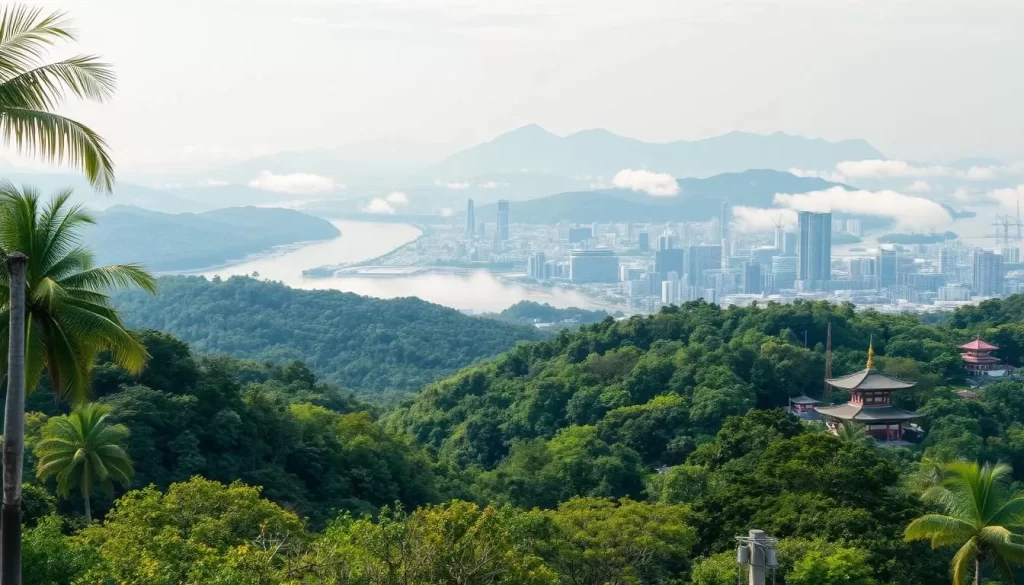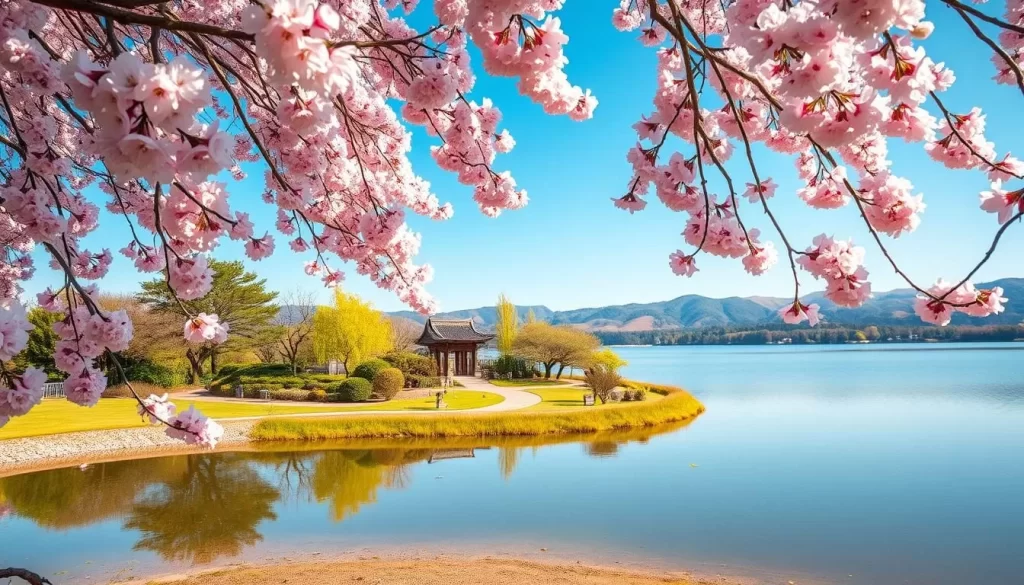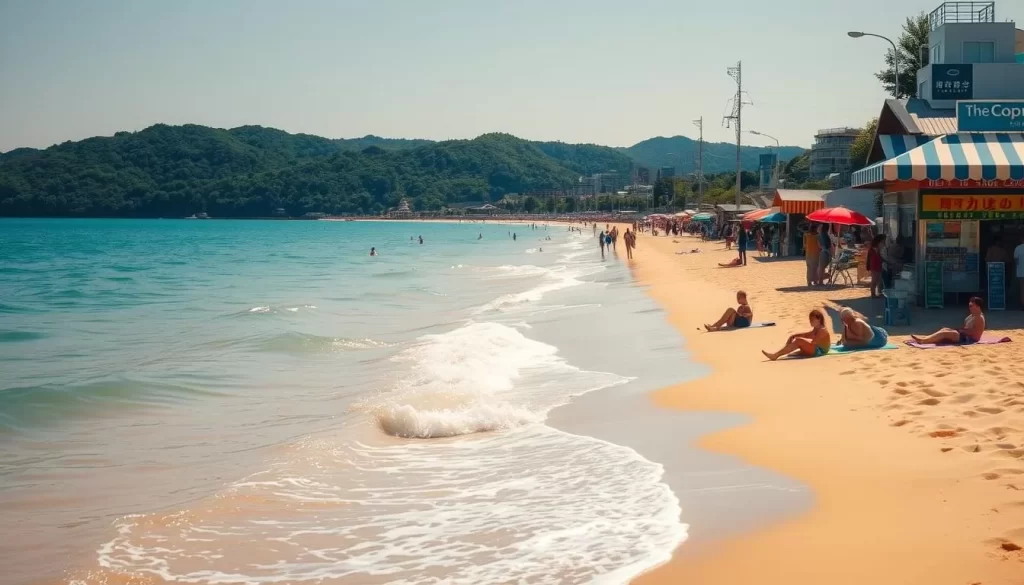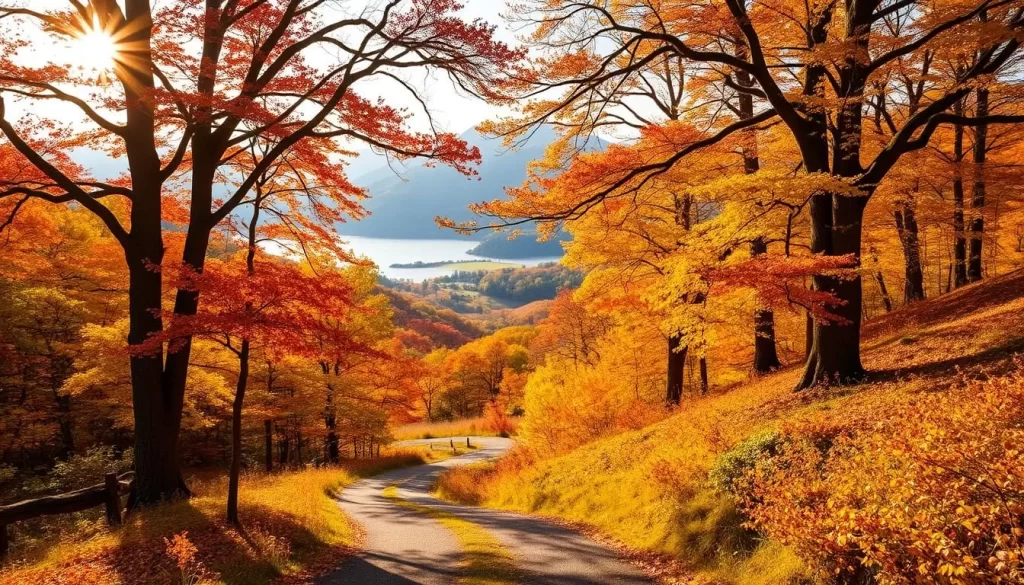✓ Accommodations✓ Flights✓ Rental Cars
Planning a trip to Chiba Prefecture can be a delightful experience, with its diverse seasonal attractions offering something for every kind of traveler. Understanding the local climate is key to making the most of your visit.
The seasonal weather patterns in Chiba vary significantly throughout the year, with temperatures ranging from 36°F to 86°F. To enjoy hot-weather activities, the best time to visit is from late July to early September.
Whether you’re looking to enjoy the famous cherry blossoms in spring or the vibrant autumn foliage, timing your trip right is crucial. This guide will help you determine the ideal time to visit based on your preferences and activities.
Understanding Chiba Prefecture’s Climate
Chiba Prefecture’s climate is a fascinating blend of seasonal changes, influenced by its unique geography. Located in the Kanto region of Japan, Chiba’s weather patterns are shaped by its proximity to the Pacific Ocean and its varied topography.
Geographic Location and Weather Influences
Chiba Prefecture’s geography plays a significant role in its climate. The prefecture’s coastline along the Pacific Ocean moderates its temperatures, while its varied landscape, including mountains and valleys, creates microclimates that can affect local weather conditions. This unique combination of factors results in a climate that is distinct from other regions in Japan.

Seasonal Overview at a Glance
Chiba Prefecture experiences four distinct seasons, each with its own characteristics. Here’s a summary:
- Spring (March to May): Mild temperatures, ranging from 43°F to 71°F, with the iconic cherry blossom season peaking in early April.
- Summer (June to August): Hot and humid, with temperatures between 67°F and 85°F, and a rainy season in June.
- Autumn (September to November): Comfortable temperatures, gradually cooling from 70°F to 50°F, making it ideal for outdoor activities and viewing autumn foliage.
- Winter (December to February): Mild winters with minimal snowfall, and temperatures rarely dropping below freezing.
Each season offers unique experiences, from festivals and cultural events to outdoor activities, making Chiba a great destination for travel throughout the year. The number of rainy days varies significantly by season, with June having the highest average at 12.9 days of precipitation.
Spring in Chiba: Cherry Blossoms and Mild Weather
The arrival of spring in Chiba marks the beginning of a season filled with festivals, outdoor activities, and pleasant weather. As the prefecture transitions from winter, the landscapes transform, offering a fresh and vibrant atmosphere.
March to May Weather Patterns
Spring in Chiba, spanning from March to May, is characterized by mild temperatures and gentle breezes. During this period, the weather gradually warms up, making it ideal for outdoor exploration. You can expect comfortable conditions for visiting various places without the harshness of other seasons.
Cherry Blossom Season: Timing and Best Viewing Spots
One of the highlights of spring in Chiba is the cherry blossom season, typically occurring in late March to early April. Popular spots for hanami (flower viewing) include parks and gardens where the blossoming trees create a picturesque landscape. You can enjoy hanami picnics under the blooming cherry trees, a beloved Japanese tradition.

The Sakura Festival in early April is a significant event, celebrating the cherry blossom season with food stalls, traditional performances, and nighttime illuminations. It’s a great way to immerse yourself in local culture and enjoy the beauty of nature.
Spring Festivals and Activities
Spring in Chiba is not just about cherry blossoms; it’s also a time for various festivals and activities. The Chiba Port Festival in May is another notable event, featuring maritime parades, seafood markets, and cultural performances that highlight the prefecture’s connection to the ocean. You can participate in these events to gain an authentic experience of local traditions.
Additionally, spring is an excellent time for outdoor activities like hiking in the Boso Peninsula, visiting Naritasan Shinshoji Temple to enjoy the blooming flowers, and exploring farmers’ markets to taste local produce. These activities allow you to engage with the local culture and enjoy the pleasant spring weather.
Summer in Chiba: Beaches, Festivals, and Humidity
Chiba Prefecture comes alive during the summer months, boasting beautiful beaches, spectacular fireworks displays, and traditional festivals that showcase local culture. As you plan your trip, it’s essential to understand the weather conditions and the array of activities available.
June to August Weather Conditions
Summer in Chiba is characterized by warm temperatures and high humidity, with average highs often reaching above 25°C (77°F). The period from June to August is peak tourist season, with July and August being the hottest months.
Navigating the Rainy Season and Typhoon Considerations
While summer is generally warm, Chiba experiences a rainy season in June, known as “Tsuyu” or “Baiyu.” Additionally, there’s a risk of typhoons, particularly in August and September. Visitors should stay informed about weather forecasts to plan their activities accordingly.
Summer Beaches and Festivals Worth Experiencing
Chiba’s coastline is a major attraction during summer, with beaches like Kujukuri offering excellent swimming and surfing opportunities. Some popular activities and events include:
- Visiting southern Chiba beaches such as Shirahama and Ubara for their clear waters and scenic surroundings.
- Attending the Chiba Port Fireworks Festival in late July, featuring spectacular pyrotechnic displays.
- Participating in local matsuri (festivals) that occur throughout summer, offering traditional music, dance, and food stalls.
- Enjoying beach barbecues in the evenings, with many coastal areas providing rental equipment and designated spaces.
These summer festivals and beach activities provide a welcome relief from the heat and humidity, allowing you to experience Japanese summer traditions while enjoying coastal breezes. Chiba Prefecture is a great destination for those looking to enjoy the beach and local culture during the summer months.

Autumn in Chiba: Fall Foliage and Comfortable Temperatures
As autumn descends upon Chiba Prefecture, the landscape transforms into a kaleidoscope of colors, making it an ideal time to experience the region’s natural beauty. The comfortable temperatures and vibrant fall foliage create a perfect setting for outdoor activities and cultural exploration.
September to November Weather Patterns
Autumn in Chiba is characterized by mild temperatures, with average highs ranging from 18°C to 23°C (64°F to 73°F) throughout September and October. As November approaches, the temperatures gradually decrease, making it an ideal time for outdoor activities. The month of September often sees some lingering summer warmth, while November brings a crispness to the air, signaling the onset of winter.
Best Spots for Autumn Leaf Viewing
Chiba is home to numerous scenic spots perfect for autumn leaf viewing (koyo). Some of the top recommendations include:
- Narita-san Shinsho-ji Temple, famous for its historic significance and beautiful autumn foliage.
- Chiba Port Aquarium and surrounding park, offering a unique blend of nature and urban attractions.
- Sawara Old Town, a historic district with traditional architecture and picturesque canals.
- Mount Nokogiri, providing panoramic views of the region and stunning autumn colors.

Fall Harvest Festivals and Cultural Events
Autumn in Chiba is not just about the fall foliage; it’s also a time for harvest festivals and cultural events. The region celebrates its agricultural bounty with numerous festivals, including:
- The Narita Autumn Festival in November, featuring traditional performances and cultural demonstrations.
- The Chiba Prefectural Sake Festival in October, offering tastings of locally produced rice wine.
- Traditional moon-viewing parties (tsukimi) in September, providing insights into Japanese autumn traditions.
These events offer a unique opportunity to experience Chiba’s culture and traditions firsthand, making your autumn visit a memorable one.
Winter in Chiba: Mild Temperatures and Festive Charm
Winter in Chiba is characterized by mild temperatures, illuminating light festivals, and traditional New Year celebrations, creating a captivating experience for visitors. You can enjoy a serene winter landscape without the harsh cold, making it an ideal time for travel and exploration.
December to February Weather Conditions
During the winter months, Chiba Prefecture experiences relatively mild weather compared to other parts of Japan. Temperatures range from around 2°C to 10°C (36°F to 50°F), making it a comfortable destination for those who prefer cooler weather without extreme cold.
The winter season is also relatively dry, with less rainfall than the summer months, making it an excellent time for outdoor activities and sightseeing.
| Month | Average Temperature (°C) | Average Rainfall (mm) |
|---|---|---|
| December | 8 | 60 |
| January | 4 | 50 |
| February | 5 | 70 |
Winter Illuminations and New Year Celebrations
Winter in Chiba is not just about the weather; it’s also a time for vibrant festivals and cultural events. One of the highlights is the winter illuminations that transform urban areas from late November through February. The Tokyo German Village’s annual light festival is one of the largest in the Kanto region, offering a magical experience.
The New Year (Oshogatsu) is Japan’s most important holiday, with many traditional customs observed at temples and shrines throughout Chiba Prefecture. You can participate in Hatsumode, the first shrine visit of the year, at major spiritual sites like Naritasan Shinshoji Temple.
It’s essential to plan your visit around the New Year period, as many shops, restaurants, and attractions may be closed or operate on limited hours between December 29 and January 4.
Chiba Prefecture, Japan: Best Months for a Weather-Savvy Trip
The key to a perfect trip to Chiba lies in understanding its seasonal weather variations. Chiba Prefecture, located near Tokyo, offers a diverse range of experiences throughout the year, making it a great destination for various types of travelers.
April-May: Ideal for Cherry Blossoms and Mild Weather
Spring is a wonderful time to visit Chiba, with April and May being particularly pleasant. The weather is mild, with temperatures gradually warming up, making it ideal for outdoor activities like cherry blossom viewing. The famous cherry blossoms typically bloom in late March to early April, attracting many visitors.
October-November: Perfect for Fall Colors and Comfortable Exploring
October and November are also excellent months to visit Chiba, offering comfortable temperatures and stunning fall foliage. The autumn leaves create a picturesque landscape, perfect for hiking and exploring the prefecture’s natural beauty.
Weather Considerations for Other Months
While spring and autumn are highlighted as ideal, other months have their characteristics worth considering. For instance, summer can be hot and humid, especially in July and August, with temperatures reaching up to 86°F. June marks the beginning of the rainy season, which might impact outdoor plans. On the other hand, winter is mild, with temperatures rarely below freezing, making it a good time for those who prefer cooler weather.
| Month | Weather Conditions | Activities |
|---|---|---|
| April-May | Mild temperatures | Cherry blossom viewing, outdoor activities |
| June-August | Hot and humid, rainy season | Beach activities, summer festivals |
| October-November | Comfortable temperatures, fall foliage | Hiking, exploring natural beauty |
| December-February | Mild winter, sunny and dry | Winter illuminations, New Year celebrations |
Understanding these seasonal variations can help you plan a weather-savvy trip to Chiba Prefecture, ensuring that you make the most of your visit.
Packing Tips for Each Season in Chiba
When planning your trip to Chiba, it’s essential to pack according to the season to make the most of your visit. Chiba Prefecture, Japan, is a destination that offers a unique experience across the four seasons.
Spring and Fall Essentials
During spring and fall, the weather in Chiba is mild and pleasant, making these seasons ideal for outdoor activities. For these periods, pack layers, including light jackets or sweaters, as the temperature can fluctuate. Comfortable walking shoes are a must, as you’ll likely explore the prefecture’s many attractions on foot.
Summer Humidity Survival Kit
In the summer, Chiba experiences high humidity and temperatures. To navigate this season comfortably, include in your packing list breathable clothing, sunscreen, a hat, and sunglasses. Staying hydrated is also crucial, so consider packing a refillable water bottle.
Winter Comfort Items
Chiba’s winter is relatively mild, with daytime temperatures typically ranging from 49-53°F. For this season, a medium-weight coat or jacket should suffice. Additionally, consider packing scarves and gloves for windier areas, comfortable walking shoes with good traction, and lip balm and moisturizer to combat dry air.
Avoiding Crowds: Strategic Timing for Your Visit
When planning your trip to Chiba, timing is everything to avoid the crowds. Understanding the best time to visit popular attractions can significantly enhance your travel experience.
Japanese Holiday Periods to Consider
It’s essential to be aware of Japanese holiday periods when planning your visit to Chiba. During these times, popular spots like Naritasan Temple and Tokyo Disney Resort tend to be more crowded. National holidays and special events can draw large crowds, so it’s wise to check the Japanese holiday calendar before your trip.
Some of the major holidays to consider include New Year’s (January 1st), Golden Week (late April to early May), and Obon (mid-August). If you can, try to avoid visiting during these peak periods for a more relaxed experience.
Weekday vs. Weekend Visitation
The day of the week you choose to visit can greatly impact your experience. Weekday visits to Chiba’s popular attractions offer a dramatically different experience compared to weekends, with significantly reduced crowds.
- Major shopping districts and entertainment venues experience their highest visitor numbers on Saturdays and Sundays.
- Natural attractions like parks and beaches see the most dramatic difference between weekday and weekend crowds.
- Planning major sightseeing for Tuesday through Thursday typically provides the optimal balance of good service and minimal crowds.
| Day | Crowd Level | Best For |
|---|---|---|
| Monday | Low | Museum visits (check for closures) |
| Tuesday-Thursday | Low | Sightseeing, shopping |
| Friday-Sunday | High | Avoid if possible |
By considering these factors, you can plan your trip to Chiba during the best time, ensuring a more enjoyable and stress-free experience.
Conclusion: Planning Your Weather-Perfect Trip to Chiba
As you plan your trip to Chiba Prefecture, understanding the best times to visit can significantly enhance your travel experience. Chiba’s diverse seasonal attractions make it a versatile destination that caters to various preferences throughout the year.
The ideal times to visit Chiba are during spring (April-May) and autumn (October-November), when the weather is mild and natural beauty is at its peak. Spring offers cherry blossoms and pleasant temperatures, while autumn brings spectacular fall foliage and comfortable conditions for exploring.
If you’re a beach enthusiast, the period from late July to early September is ideal for warm water temperatures and optimal swimming conditions. Conversely, winter visits provide unique opportunities to experience Japanese New Year traditions and winter illuminations with fewer crowds and lower accommodation rates.
Regardless of when you choose to visit, understanding Chiba’s weather patterns allows you to pack appropriately and plan activities that maximize your enjoyment. By strategically timing your visit to avoid Japanese holiday periods and weekends, you can experience Chiba’s attractions with fewer crowds and more authentic local interactions.
With its cultural sites, natural beauty, and proximity to Tokyo, Chiba rewards weather-savvy travelers with memorable experiences throughout the year.
The above is subject to change.
Check back often to TRAVEL.COM for the latest travel tips and deals.






